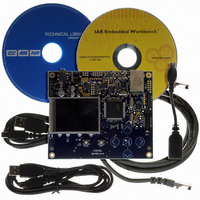ATEVK1105 Atmel, ATEVK1105 Datasheet - Page 421

ATEVK1105
Manufacturer Part Number
ATEVK1105
Description
KIT EVAL FOR AT32UC3A0
Manufacturer
Atmel
Series
AVR®32r
Type
MCUr
Datasheets
1.ATAVRONE-PROBECBL.pdf
(16 pages)
2.ATEVK1104.pdf
(826 pages)
3.ATEVK1105.pdf
(28 pages)
Specifications of ATEVK1105
Contents
Evaluation Board, Software and Documentation
Processor To Be Evaluated
AT32UC3A0512
Processor Series
AVR
Data Bus Width
32 bit
Interface Type
USART, TWI, USB, SPI, Ethernet
Operating Supply Voltage
3.3 V
Silicon Manufacturer
Atmel
Core Architecture
AVR
Core Sub-architecture
AVR UC3
Silicon Core Number
AT32UC3A0512
Silicon Family Name
AVR
Kit Contents
Board CD Docs
Rohs Compliant
Yes
For Use With/related Products
AT32UC3A0
Lead Free Status / RoHS Status
Lead free / RoHS Compliant
- Current page: 421 of 826
- Download datasheet (20Mb)
Figure 28-9. Self-refresh Mode Behavior
28.7.5.2
32058J–AVR32–04/11
SDRAMC_A[12:0]
SDRAMC_SRR
SDCKE
SDWE
SDCK
SDCS
Write
RAS
CAS
Low-power Mode
SRCB = 1
After initialization, as soon as PASR/DS/TCSR fields are modified and self-refresh mode is acti-
vated, the Extended Mode Register is accessed automatically and PASR/DS/TCSR bits are
updated before entry into self-refresh mode.
The SDRAM device must remain in self-refresh mode for a minimum period of t
remain in self-refresh mode for an indefinite period. This is described in
This mode is selected by programming the LPCB field to 2 in the SDRAMC Low Power Register.
Power consumption is greater than in self-refresh mode. All the input and output buffers of the
SDRAM device are deactivated except SDCKE, which remains low. In contrast to self-refresh
mode, the SDRAM device cannot remain in low-power mode longer than the refresh period (64
ms for a whole device refresh operation). As no auto-refresh operations are performed by the
SDRAM itself, the SDRAM Controller carries out the refresh operation. The exit procedure is
faster than in self-refresh mode.
This is described in
Figure
28-10.
Self Refresh Mode
to the SDRAM Controller
Access Request
T
Figure
XSR
AT32UC3A
= 3
28-9.
RAS
Row
and may
421
Related parts for ATEVK1105
Image
Part Number
Description
Manufacturer
Datasheet
Request
R

Part Number:
Description:
DEV KIT FOR AVR/AVR32
Manufacturer:
Atmel
Datasheet:

Part Number:
Description:
INTERVAL AND WIPE/WASH WIPER CONTROL IC WITH DELAY
Manufacturer:
ATMEL Corporation
Datasheet:

Part Number:
Description:
Low-Voltage Voice-Switched IC for Hands-Free Operation
Manufacturer:
ATMEL Corporation
Datasheet:

Part Number:
Description:
MONOLITHIC INTEGRATED FEATUREPHONE CIRCUIT
Manufacturer:
ATMEL Corporation
Datasheet:

Part Number:
Description:
AM-FM Receiver IC U4255BM-M
Manufacturer:
ATMEL Corporation
Datasheet:

Part Number:
Description:
Monolithic Integrated Feature Phone Circuit
Manufacturer:
ATMEL Corporation
Datasheet:

Part Number:
Description:
Multistandard Video-IF and Quasi Parallel Sound Processing
Manufacturer:
ATMEL Corporation
Datasheet:

Part Number:
Description:
High-performance EE PLD
Manufacturer:
ATMEL Corporation
Datasheet:

Part Number:
Description:
8-bit Flash Microcontroller
Manufacturer:
ATMEL Corporation
Datasheet:

Part Number:
Description:
2-Wire Serial EEPROM
Manufacturer:
ATMEL Corporation
Datasheet:










